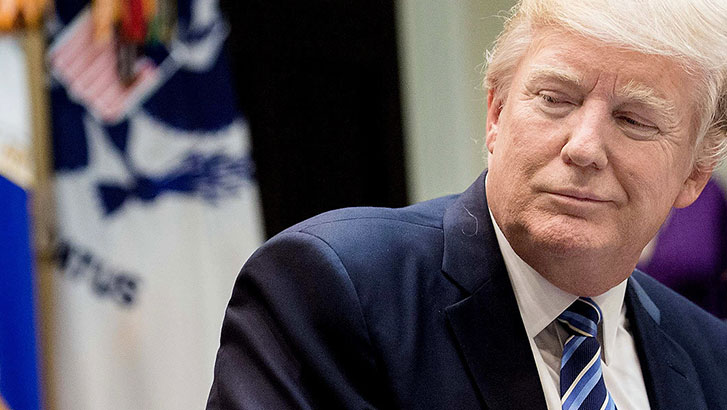President Trump calls for end to ‘agonising Green Card wait’, asks US lawmakers to bring in bill to help legal Indian-American migrants
Washington: President Donald Trump on Wednesday asked US lawmakers to vote for an immigration bill which among other things would end the agonising green card wait for Indian Americans and promote immigration that would enable a much smoother and faster process for legal migration of qualified professionals from countries like India.
Trump’s open call to US lawmakers came hours before the House of Representatives was scheduled to vote on the Border Security and Immigration Reform Act which is also known as the Goodlatte Bill as it was introduced by Republican Congressman Bob Goodlatte from Virginia.
HOUSE REPUBLICANS SHOULD PASS THE STRONG BUT FAIR IMMIGRATION BILL, KNOWN AS GOODLATTE II, IN THEIR AFTERNOON VOTE TODAY, EVEN THOUGH THE DEMS WON’T LET IT PASS IN THE SENATE. PASSAGE WILL SHOW THAT WE WANT STRONG BORDERS & SECURITY WHILE THE DEMS WANT OPEN BORDERS = CRIME. WIN!
— Donald J. Trump (@realDonaldTrump) June 27, 2018
Read More | Indians With Advanced Degree May Have to Wait 151 Years for Green Card, Says Report
“Passage will show that we want strong borders and security while the dems want open borders = crime. Win!” said the president in his open support to the bill which has been introduced by Goodlatte, chairman of the House Judiciary Committee, Congressman Carlos Curbelo, House Homeland Security Committee Chairman Michael McCaul, and Congressman Jeff Denham. The Border Security and Immigration Reform Act of 2018 (HR 6136) establishes a new, merit-based green card programme – without increasing legal immigration – based on applicants earning points for skills, education, vocational training, work experience, English language proficiency, and military service, according to Goodlatte.
More points are awarded for each achievement. Once applicants meet the threshold number of points for eligibility, they will qualify for a green card, although those with the highest points each year will earn their green cards more quickly.
Those eligible for this include children of E1, E2, H1B, and L workers who were brought by their parents lawfully into the US as minors and have been continuously in the US for 10 years before the date of enactment and any individual granted a “contingent non-immigrant status” due to DACA eligibility may apply.
Importantly, the bill also requires the border wall to be funded before new visas are available under the new merit-based programme. This means that there could be increased cost for getting a Green Card or permanent legal residency in the US. The first proposal in this regard, had come from Indian professionals who are in long agonising wait for a Green Card, Goodlatte said.
The bill, which has very little chance to be cleared by the Senate, provides nearly $25 billion in advance appropriations to build a wall along the Southern border. It also combats visa overstays by ensuring the biometric entry-exit programme is completed so that they know whether or not those on temporary visas leave the US.
For Trump to sign this into law, the bill needs to be passed by the House and the Senate. While it is likely to sail through the House easily, its passage in the Senate would be a tough task for the Republicans, who have a slender thin majority of 51 in a 100-member Senate. Congressional laws require Republicans to have 60 votes to clear procedural hurdles, which means that they need support of nine Senators from the opposition Democratic party.
Trump in his recent remarks and today’s tweet said that this is an impossible task given the bitterness between the Republican and the Democrats. Supported by Trump, the bill contains more tools to prevent illegal immigration. It ends “catch and release,” increases the standard for credible fear to root out fraudulent claims, ensures unaccompanied alien children are returned safely and quickly to their home country, and provides the Department of Homeland Security (DHS) with the ability to detain dangerous criminal aliens, among other provisions.
As part of its effort to modernise the immigration system, the bill ends the visa lottery, protects the nuclear family while reducing chain migration, reduces overall immigration numbers over the long term, and begins a shift to a merit-based system.
It also shifts to a first-in-line visa system by eliminating the per-country cap on employment-based green cards and by increasing the cap on family-sponsored green cards from seven to 15 percent. The legislation allows the DACA population – children who came to the US as minors and grew up here – an opportunity to earn a legal status. If these individuals meet certain requirements they will be eligible for a 6-year renewable legal status, allowing them to work here and travel abroad.
Aiming to creates a new merit-based Green Card Programme that encourages advancement, the bill establishes a new, merit-based green card programme – without increasing legal immigration – based on applicants earning points for skills, education, vocational training, work experience, English language proficiency, and military service. More points are awarded for each achievement, said Goodlatte.
“Once applicants meet the threshold number of points for eligibility, they will qualify for a green card, although those with the highest points each year will earn their green cards more quickly,” he said.
“Importantly, the bill also requires the border wall to be funded before new visas are available under the new merit-based programme,” said the lawmaker.



